Worlds of The Solar System
Following list contains all bodies of our Solar System photographed from close range at satisfying resolution (+ several poorly resolved bodies + growing number of asteroids imaged by ground-based adaptive optics + few farout smudges captured by Hubble + some other notable objects) sorted roughly by size:
1 Main sequence star 4 Giant gaseous planets 4 Dense rocky planets 7 Large planetary moons 3 (+9) Dwarf icy planets 11 (+1) Round icy moons 0 (+6) Kuiper belt planetoids 1 (+2) Main belt planetoids 2 (+2) Transitional moons 0 (+20) Big Main belt asteroids 0 (+4) Centaurs 4 (+4) Big irregular moons 0 (+8) Jovian trojans and their satellites 4 (+2) Medium Main belt asteroids 8 (+4) Medium irregular moons 1 Medium Kuiper belt object 2 (+4) Small irregular moons 4 (+8) Small Main belt asteroids and satellites 4 (+4) Comets 7 (+13) Near-Earth asteroids and their satellites
67 (+91) = 158 objects in total
Many more objects are mentioned just by name (117) or overall population in each category.
Other way to sort the worlds is by the realm which they occupy:
Inner Worlds | Mars and The Belt | Trojans, Comets, Centaurs | Jupiter System | Saturn System | Uranus System | Neptune System | Outer Realms
Main sequence star ↑

Sun (☉)
1 392 000 km
 |
 |
 |
 |
| Jupiter (♃) 139 822 km |
Saturn (♄) 116 464 km |
Uranus (♅) 50 724 km |
Neptune (♆) 49 244 km |
 |
 |
 |
 |
| Earth (♁) 12 742 km |
Venus (♀) 12 104 km |
Mars (♂) 6 779 km |
Mercury (☿) 4 879 km |
 |
 |
 |
| Ganymed (♃) 5 268 km |
Titan (♄) 5 152 km |
Callisto (♃) 4 821 km |
 |
 |
 |
 |
| Io (♃) 3 643 km |
Luna (♁) 3 474 km |
Europa (♃) 3 122 km |
Triton (♆) 2 707 km |
 |
 |
 |
 |
| Pluto (♇) 2 374 km |
Eris (E) 2 326 km |
Haumea (H) 2 100 × 1 680 × 1 074 km |
Makemake (M) 1 430 km |
 |
 |
 |
 |
| Charon (♇) 1 212 km |
Gonggong (G) 1 210 km |
Quaoar (Q) 1 120 km |
Sedna ~ 1 000 km |
 |
 |
 |
 |
| Ceres (⚳) 946 km |
Orcus (O) ~ 900 km |
Salacia (S) ~ 850 km |
2002 MS4 ~ 800 km |
 |
 |
 |
 |
| Titania (♅) 1 577 km |
Rhea (♄) 1 528 km |
Oberon (♅) 1 523 km |
Iapetus (♄) 1 469 km |
 |
 |
 |
 |
| Umbriel (♅) 1 169 km |
Ariel (♅) 1 158 km |
Dione (♄) 1 123 km |
Tethys (♄) 1 062 km |
 |
 |
 |
 |
| Dysnomia (E) ~ 600 km |
Enceladus (♄) 504 km |
Miranda (♅) 472 km |
Mimas (♄) 396 km |
 |
 |
 |
 |
 |
 |
| Varda (V) ~ 700 km |
Varuna ~ 1000 × 600 km |
Ixion ~ 700 km |
2002 AW197 ~ 700 km |
2003 AZ84 (A) ~ 900 × 500 km |
2013 FY27 (F) ~ 700 km |
| & |
| roughly 200 known trans-Neptunians bigger than 400 km |
 |
 |
 |
| Vesta (⚶) 573 × 557 × 446 km |
Pallas (⚴) 550 × 516 × 476 km |
Hygiea (⚕) 530 × 407 × 370 km |
Equilibrium
transition
 |
 |
 |
 |
| Proteus (♆) 424 × 390 × 396 km |
Nereid (♆) ~ 340 km |
Hyperion (♄) 360 × 266 × 205 km |
Phoebe (♄) 219 × 217 × 204 km |
| & |
| Vanth(O), Ilmarë(V), Hi'iaka(H), Actaea(S), Weywot(Q) |
 |
 |
 |
 |
 |
| Interamnia ~ 330 km |
Europa ~ 320 km |
Davida ~ 300 km |
Sylvia ~ 280 km |
Eunomia ~ 270 km |
 |
 |
 |
 |
 |
| Euphrosyne ~ 270 km |
Juno ~ 250 km |
Cybele ~ 240 km |
Bamberga ~ 230 km |
Psyche ~ 220 km |
 |
 |
 |
 |
 |
| Thisbe ~ 220 km |
Doris ~ 220 km |
Fortuna ~ 210 km |
Themis ~ 210 km |
Amphitrite ~ 200 km |
 |
 |
 |
 |
 |
| Egeria ~ 200 km |
Iris ~ 200 km |
Elektra ~ 200 km |
Hebe ~ 200 km |
Kleopatra 270 × 90 × 80 km |
| & |
| Patientia, Herculina, Camilla, Ursula, Eugenia, Hermione, Aurora, Daphne, Bertha, Aegle, Palma, Metis, Alauda, Hilda |
| + roughly 200 Main belt asteroids bigger than 100 km |
 |
 |
 |
 |
| Chariklo 296 × 264 × 204 km |
Chiron ~ 200 km |
Bienor ~ 200 km |
Pholus ~ 310 × 150 km |
| & |
| roughly 40 known centaurs bigger than 100 km |
 |
 |
 |
 |
| Larissa (♆) 216 × 204 × 168 km |
Janus (♄) 203 × 185 × 153 km |
Amalthea (♃) 250 × 146 × 128 km |
Puck (♅) ~ 160 km |
 |
 |
 |
 |
| Epimetheus (♄) 130 × 114 × 106 km |
Thebe (♃) 116 × 98 × 84 km |
Prometheus (♄) 136 × 79 × 59 km |
Pandora (♄) 104 × 81 × 64 km |
| & |
| S2018(F), S2015(M), Xiangliu(G), Galatea(♆), Himalia(♃), Namaka(H), Sycorax(♅), Despina(♆), Portia(♅), Juliet(♅), Thalassa(♆), Belinda(♅), Elara(♃), Cressida(♅) |
 |
 |
 |
 |
| Hektor ~ 220 & 180 km |
Agamemnon ~ 190 × 140 km |
Patroclus 127 × 117 × 98 km |
Menoetius 117 × 108 × 90 km |
 |
 |
 |
 |
| Eurybates ~ 64 km |
Orus ~ 51 km |
Leucus ~ 34 km |
Polymele ~ 21 km |
| & |
| satellites: Skamandrios(He), S2012(Ag), S2022(Po), Queta(Eu), ... |
| + roughly 550 Jovian trojans bigger than 20 km |
 |
 |
 |
| Lutetia 121 × 101 × 75 km |
Justitia ~ 54 km |
Mathilde 66 × 48 × 46 km |
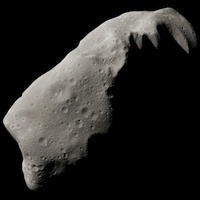 |
 |
 |
| Ida 60 × 25 × 19 km |
Chimaera ~ 44 km |
Gaspra 18 × 11 × 9 km |
| & |
| roughly 2100 Main belt asteroids bigger than 20 km |
 |
 |
 |
 |
| Metis (♃) 60 × 40 × 34 km |
Hydra (♇) 51 × 36 × 31 km |
Nix (♇) 50 × 33 × 31 km |
Helene (♄) 45 × 39 × 26 km |
 |
 |
 |
 |
| Atlas (♄) 41 × 35 × 19 km |
Pan (♄) 35 × 28 × 21 km |
Telesto (♄) 33 × 23 × 19 km |
Calypso (♄) 29 × 19 × 13 km |
 |
 |
 |
 |
| Phobos (♂) 26 × 23 × 18 km |
Deimos (♂) 15 × 12 × 11 km |
Kerberos (♇) 19 × 10 × 9 km |
Styx (♇) 16 × 9 × 8 km |
| & |
| S2005(A), Rosalind(♅), Desdemona(♅), Halimede(♆), Naiad(♆), Neso(♆), Pasiphae(♃), Bianca(♅), Prospero(♅), Setebos(♅), Carme(♃), Sao(♆), Ophelia(♅), Lysithea(♃), |
| Caliban(♅), Laomedeia(♆), Cordelia(♅), Psamathe(♆), Siarnaq(♄), Sinope(♃), Hippocamp(♆), Stephano(♅), Ananke(♃), Albiorix(♄), Perdita(♅), Paaliaq(♄), |
| Francisco(♅), Leda(♃), Ferdinand(♅), Margaret(♅), Ymir(♄), Trinculo(♅), Cupid(♅), Adrastea(♃), Kiviuq(♄), Tarvos(♄), Ijiraq(♄), Erriapus(♄) |
 |
| Arrokoth 21×20×9 & 15×14×10 km |
| & |
| more than 4000 known trans-Neptunians | milions more are estimated to exist |
 |
 |
 |
| Daphnis (♄) 9 × 8 × 6 km |
Pallene (♄) 6 × 4 × 4 km |
Methone (♄) 4 × 3 × 2 km |
 |
 |
 |
| Polydeuces (♄) 3 × 3 × 2 km |
Anthe (♄) ~ 1.8 km |
Aegaeon (♄) 1.4 × 0.5 × 0.4 km |
| & |
| Mab(♅), Callirrhoe(♃), Skathi(♄), Hyrrokin(♄), Themisto(♃), Praxidike(♃), Bestla(♄), Tarqeq(♄), Mundilfari(♄), Narvi(♄), Suttungr(♄), Thrymr(♄), Kari(♄), Megaclite(♃), |
| Bebhionn(♄), Skoll(♄), Greip(♄), Jarnsaxa(♄), Bergelmir(♄), Hati(♄), Aegir(♄), Surtur(♄), Loge(♄), Fornjot(♄), Iocaste(♃), Taygete(♃), Kalyke(♃), Farbauti(♄), Fenrir(♄) |
| + roughly 165 known moons smaller than 5 km |
 |
 |
 |
 |
| 1999 SG6 ~ 8 km |
1998 RC76 ~ 7 km |
Šteins 7 × 6 × 4 km |
Annefrank 7 × 5 × 3 km |
 |
 |
 |
 |
| 2000 VA28 ~ 5 km |
Rockox ~ 5 km |
Donaldjohanson ~ 4 km |
Westerwald ~ 2 km |
 |
 |
 |
 |
| Braille ~ 2 × 1 km |
Dactyl (Ida) 1.6 × 1.4 × 1.2 km |
Dinkinesh ~ 0.7 km |
S2023Dinkinesh1 ~ 0.2 & 0.2 km |
| & |
| roughly 90 000 Main belt asteroids >5 km | 750 000 >1 km | 25 000 000 >0.1 km |
| + satellites: Linus, Petit-Prince, Romulus, Alexhelios, Remus, Cleoselene, S2003Elektra1, |
| S2004Eugenia1, S2019Euphrosyne1, Pichi üñëm, S2014Elektra1, S2014Elektra2, Peneius, ... |
 |
 |
 |
 |
| Halley 15 × 8 × 8 km |
Tempel 1 8 × 5 × 5 km |
Borrelly 8 × 4 × 4 km |
Wild 2 6 × 4 × 3 km |
 |
 |
 |
 |
| Churyumov-Gerasimenko 4×3×2 & 3×2×2 km |
Hartley 2 2 × 1 × 1 km |
289P/Blanpain ~ 2 km |
311P/PANSTARRS ~ 0.5 km |
| & |
| almost 400 numbered comets | thousands known comets | probably trillion(s) dormant comets |
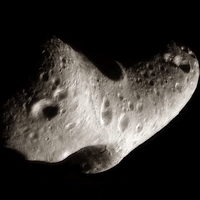 |
 |
 |
 |
| Eros 34 × 11 × 11 km |
1999 JM8 ~ 6 km | Phaethon ~ 6 km |
Florence & °° ~ 4.4 & 0.3 & 0.2 km |
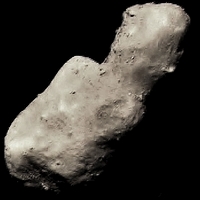 |
 |
 |
 |
| Toutatis 4.7 × 2.4 × 2 km |
Heracles & ° ~ 3.6 & 0.6 km |
Tantalus ~ 3 km |
1996 FG3 & ° ~ 1.7 & 0.3 km |
 |
 |
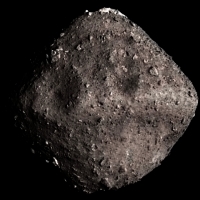 |
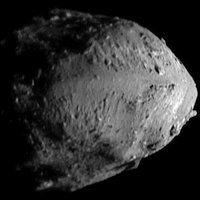 |
| Moshup & Squannit ~ 1.3 & 0.4 km |
2005 UD ~ 1.3 km |
Ryugu 0.9 km |
Didymos 0.8 km |
 |
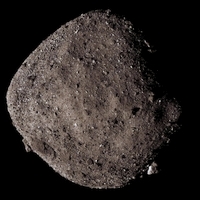 |
 |
 |
| 2001 CC21 ~ 0.5 km |
Bennu 0.5 km |
Itokawa 0.5 × 0.3 × 0.2 km |
Apophis ~ 0.4 × 0.2 km |
 |
 |
 |
 |
| Dimorphos (Didymos) 0.16 km |
Kamo'oalewa ~ 0.05 km |
2019 VL5 ~ 0.03 km |
1998 KY26 ~ 0.03 km |
| & |
| roughly 930 Near-Earth asteroids >1 km | 30 000 >0.1 km | probably something in order of billion(s) of meter-sized NEAs |
Still don't have enough of worlds? Check out which of them were visited for the first time in recent years.
The table below summarizes which dots in the sky will (hopefuly) turn into wonderous worlds in following years:
Soon to be visited worlds
(Unfamiliar objects awaiting first exploration)
| Year | Object | Class | Group | Spectral type | Size | Spacecraft |
| 2025 | Donaldjohanson | MBA | Erigone family | C | 4 km | Lucy (NASA) |
| 2026 | Kamo'oalewa | quasi-satellite | Apollo | ? | 50 m | Tianwen-2 (CNSA) |
| 2026 | 2001 CC21 | NEA | Apollo | S | 0.5 km | Hayabusa2♯ (JAXA) |
| 2027 | 2019 VL5 | NEA | Aten | ? | 30 m | ADM (CNSA) |
| 2027 | Eurybates & Queta | Jovian trojan | leading | C | 60 km & 1 km | Lucy (NASA) |
| 2027 | Polymele & ° | Jovian trojan | leading | P | 20 km & 5 km | Lucy (NASA) |
| 2028 | Phaethon | NEA | Apollo/active | B | 6 km | DESTINY+ (JAXA) |
| 2028 | Leucus | Jovian trojan | leading | D | 30 km | Lucy (NASA) |
| 2028 | Orus | Jovian trojan | leading | D | 50 km | Lucy (NASA) |
| 2028 | 2005 UD | NEA | Apollo | B/C | 1.3 km | DESTINY+ (JAXA) |
| 2029 | Psyche | MBA | metallic | M | 230 km | Psyche (NASA) |
| 2029 | Apophis | NEA | Aten | Sq | 0.4 km | OSIRIS-APEX (NASA) |
| 2030 | Westerwald | MBA | ? | 2 km | MBR Explorer (UAE) | |
| 2030 | Chimaera | MBA | Chimaera family | Xc | 44 km | MBR Explorer (UAE) |
| 2031 | Rockox | MBA | ? | 5 km | MBR Explorer (UAE) | |
| 2031 | 1998 KY26 | NEA | Apollo | X | 30 m | Hayabusa2♯ (JAXA) |
| 2032 | 2000 VA28 | MBA | ? | 5 km | MBR Explorer (UAE) | |
| 2032 | 1998 RC76 | MBA | ? | 7 km | MBR Explorer (UAE) | |
| 2033 | 1999 SG6 | MBA | ? | 8 km | MBR Explorer (UAE) | |
| 2033 | Patroclus & Menoetius | Jovian trojan | trailing | P | 113 km & 104 km | Lucy (NASA) |
| 2034 | 311P/PANSTARRS | MBA | active | ? | 0.5 km | Tianwen-2 (CNSA) |
| 2034 | Heracles & ° | NEA | Apollo | O | 3.6 km & 0.6 km | DESTINY+ (JAXA) |
| 2034 | Justitia | MBA | very red | D | 54 km | MBR Explorer (UAE) |
| 2035 | 289P/Blanpain | comet | short-period | ? | 2 km | DESTINY+ (JAXA) |
| 2038 | Tantalus | NEA | Apollo | Q | 3 km | DESTINY+ (JAXA) |
Last update: 11/2023